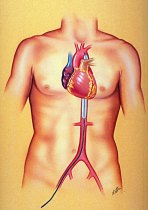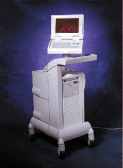 Dr. Adrian Kantrowitz introduced the intra-aortic balloon pump (IABP) in the late 1960s as a simple yet effective device to increase coronary perfusion. Because it is easy to insert, the IABP is the most widely used form of mechanical circulatory support. At the Texas Heart Institute, the IABP is now used in more than 450 patients each year.
Dr. Adrian Kantrowitz introduced the intra-aortic balloon pump (IABP) in the late 1960s as a simple yet effective device to increase coronary perfusion. Because it is easy to insert, the IABP is the most widely used form of mechanical circulatory support. At the Texas Heart Institute, the IABP is now used in more than 450 patients each year.
Although the IABP was first used for surgical patients, the pump can now be used along with interventional cardiology procedures and medical therapy (medications). Indications for its use include:
- Failure to wean from cardiopulmonary bypass.
- Cardiogenic shock.
- Heart failure.
- Acute heart attack.
- Support during high-risk percutaneous transluminal coronary (balloon) angioplasty, rotoblator procedures, and coronary stent placement.
The Pump
 The IABP is a polyethylene balloon mounted on a catheter, which is generally inserted into the aorta through the femoral artery in the leg. The pump is available in a wide range of sizes (2.5 cc to 50 cc) that will fit patients of any age and size. The balloon is guided into the descending aorta, approximately 2 cm from the left subclavian artery. At the start of diastole, the balloon inflates, augmenting coronary perfusion. At the beginning of systole, the balloon deflates; blood is ejected from the left ventricle, increasing the cardiac output by as much as 40 percent and decreasing the left ventricular stroke work and myocardial oxygen requirements. In this manner, the balloon supports the heart indirectly.
The IABP is a polyethylene balloon mounted on a catheter, which is generally inserted into the aorta through the femoral artery in the leg. The pump is available in a wide range of sizes (2.5 cc to 50 cc) that will fit patients of any age and size. The balloon is guided into the descending aorta, approximately 2 cm from the left subclavian artery. At the start of diastole, the balloon inflates, augmenting coronary perfusion. At the beginning of systole, the balloon deflates; blood is ejected from the left ventricle, increasing the cardiac output by as much as 40 percent and decreasing the left ventricular stroke work and myocardial oxygen requirements. In this manner, the balloon supports the heart indirectly.
The balloon is inflated with helium, an inert gas that is easily absorbed into the bloodstream in case of rupture. Inflation of the balloon can be triggered according to the patient's electrocardiogram, their blood pressure, a pacemaker (if they have one), or by a pre-set internal rate.
 The Console
The Console
The IABP is driven by the balloon pump console. The operating controls are located on a touch pad below the display monitor and can be programmed to produce rates as high as 140 beats per minute. The on-board battery provides power for up to 2 hours.
The new CS100 IntelliSync console, with one-button start up, automatically adapts to patients' changing conditions.
For more information, you can read an article entitled, "Counterpulsation: historical background, technical improvements, hemodynamic and metabolic effects," which appears in Volume 84 (1994) of the journal Cardiology (pp. 156-167).



